One Tile at a Time
Permanent link
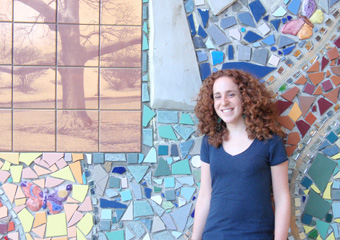
Orit Vardi stands in front of Growing 2008, the mural being created under her supervision by 30 youth in the Bricolage program.
Over the past year, while walking or running under the Bryn Mawr underpass at Lake Shore Drive, I’ve admired the sparkling colors and tiles, wondering who was responsible for this gorgeous mural. Then, a few months ago, my friend Orit mentioned that she was hiring teens to create another mural for the Bryn Mawr underpass.
Wait - did they already do one on the north side of the street? Can I help? Will you hire me? She responded accordingly, “Sure, if you’re under 18.”
I got past my disappointment (eventually) and spoke with Orit, about her experience in Avodah: The Jewish Service Corps, her job at Alternatives, and Bricolage, the program responsible for the mosaic murals.
Avodah is sort of like The Real World, sans camera. For one year, seven Jewish young adults live together in an Andersonville apartment and each work at a different nonprofit. They learn about social justice and each other’s Jewish backgrounds and religious practices. Orit explains, “We spent the year learning about different issues in the city, looking at Jewish roots and values, discussing the Jewish outlook on social justice, and talking about how we can bring all of those things together in the work that we do and in the lives that we lead. It’s been a really inspirational year.”
Many of the issues the group learned about during the year - housing, homelessness, environmental justice, incarceration – have directly affected many youth that Orit counsels at Alternatives, where she works in career and employment services. She helps youth ages 16-24 who don’t have many resources at home to prepare for their first jobs, write resumes, research colleges, explore careers, conduct interviews, fill out applications and more.
For 30 fortunate youth, the Bricolage program is their first summer job. Teens under 18 have to go through an extensive application process, including an interview with Orit, who supervises the program.
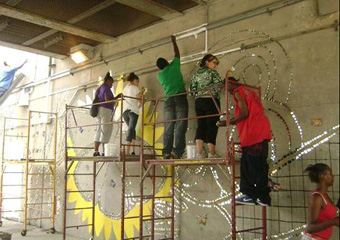
Hard at work, using mirror tiles to outline large images
In its third summer, the Bricolage program is well under way. I couldn’t believe the progress that had been made since the first tiles were installed on July 2. Only a few weeks prior I had run past and noticed mirror tiles forming simple outlines across the wall. It looked vastly different the other day when I stopped by to check it out.
As I walked up to the site, a car drove by honking at the teens and someone leaned out the window and yelled, “It looks beautiful!” And it does.
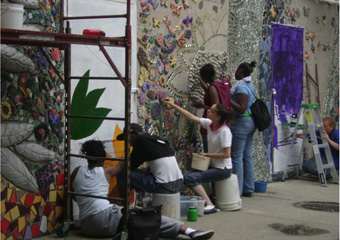
The mural is progressing. Ceramic flowers and butterflies made by community groups fill the center of the wall, forming a community garden.
The theme for this year’s mural is, Growing 2008. The images focus on nature and history in the Edgewater community. The middle of the mural features a community garden that was literally made by the community. Different community groups, including Heartland Alliance, church groups, book clubs, youth groups, and others made ceramic flowers and butterflies earlier this year that the teens then glazed and included in the mural.
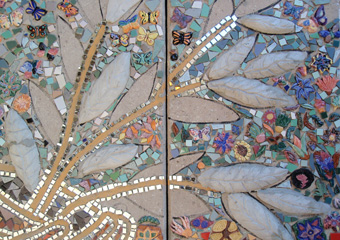
Sculpted leaves jut out of the wall, adding texture and variety to the mural’s community garden.
Another section contains a family tree, featuring a photo wall of past and present community members. Throughout the mural are historic Edgewater buildings, leaves, flowers, animals, and patterns that represent different ethnic groups in Edgewater.
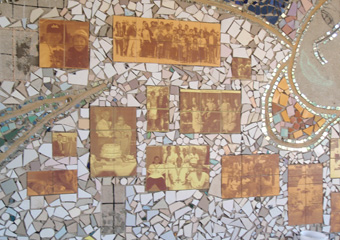
The family tree portion of the mural depicts past and present Edgewater community members.
The two artists leading the process are high school art teachers Tracy Van Duinen and Todd Osborne. They created the design along with the help of the community – condo associations, senior centers, the Edgewater Community Council, individual families and others are all involved in planning and executing the designs along with the youth.
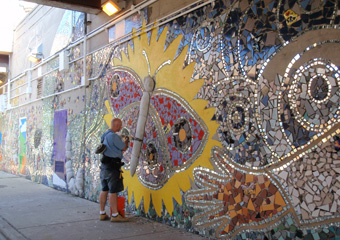
Artist Tracy Van Duinen touches up some cement before debriefing about the day with the youth apprentices.
Van Duinen explained that this is a way for teens to get involved in their community in a new way. Orit agrees that the youth are definitely feeling a sense of community from the project. The media usually portrays teenagers in a negative light, but during this project, she says, every single day, “you have community members walking by, talking to them and asking them questions, clapping, telling them just how wonderful they are, and how they’re really leaving their print on the community.”
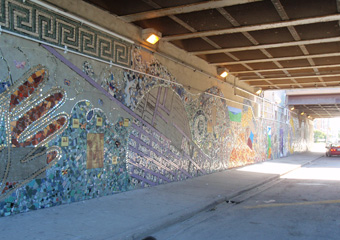
With only a few weeks left, the mural is almost complete. Each purple line in the grid above represents a street in the Edgewater neighborhood.
Besides a sense of pride at their accomplishments, youth are gaining both art skills, professional skills and a sense of community. The project culminates with a huge community event on Saturday, August 9th which the mayor and alderman both plan to attend.
This sense of community and the importance of giving back to the community was a theme in Avodah as well. Orit only worked with one Jewish teen during this past year, but she notes that the Jewish component of her work is expressed through implementing Jewish values instead - looking at Jewish texts and ideologies and reaching a state of equal justice for all. “Judaism is involved even when you’re not at a Jewish organization or working with a Jewish population.”
Stop by and check out the mural at Bryn Mawr under Lake Shore Drive. It’s almost complete, and on a sunny day the light ripples across the tiles bringing the images to life. Last year’s mural, Living 2007, is on the north side of the street; Growing 2008 is on the south.


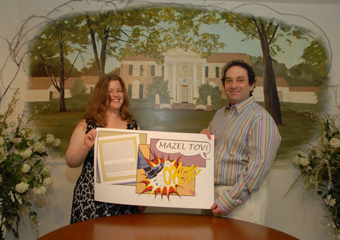
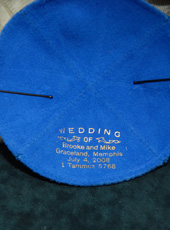
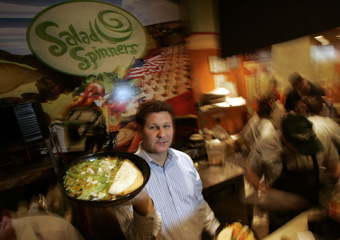
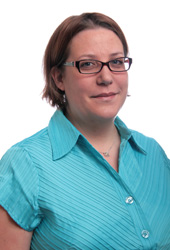

.jpg)



